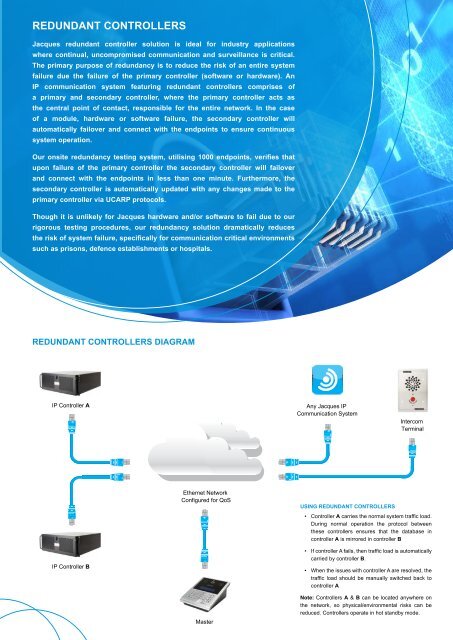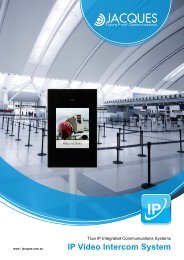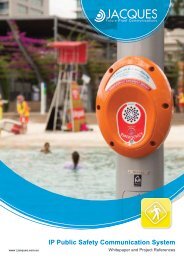Product Catalogue | 2015
Create successful ePaper yourself
Turn your PDF publications into a flip-book with our unique Google optimized e-Paper software.
REDUNDANT CONTROLLERS<br />
Jacques redundant controller solution is ideal for industry applications<br />
where continual, uncompromised communication and surveillance is critical.<br />
The primary purpose of redundancy is to reduce the risk of an entire system<br />
failure due the failure of the primary controller (software or hardware). An<br />
IP communication system featuring redundant controllers comprises of<br />
a primary and secondary controller, where the primary controller acts as<br />
the central point of contact, responsible for the entire network. In the case<br />
of a module, hardware or software failure, the secondary controller will<br />
automatically failover and connect with the endpoints to ensure continuous<br />
system operation.<br />
Our onsite redundancy testing system, utilising 1000 endpoints, verifies that<br />
upon failure of the primary controller the secondary controller will failover<br />
and connect with the endpoints in less than one minute. Furthermore, the<br />
secondary controller is automatically updated with any changes made to the<br />
primary controller via UCARP protocols.<br />
Though it is unlikely for Jacques hardware and/or software to fail due to our<br />
rigorous testing procedures, our redundancy solution dramatically reduces<br />
the risk of system failure, specifically for communication critical environments<br />
such as prisons, defence establishments or hospitals.<br />
DISTRIBUTED NETWORKS DIAGRAM<br />
DISTRIBUTED NETWORKS<br />
CONTROLLERS AND SOFTWARE | 17<br />
The Jacques IP Communications System supports distributed networks which can be<br />
located at different sites.<br />
The system has hot standby, redundant controllers at site A. Multiple transmission<br />
links provide for alternate routing of network traffic should any link fail. In addition,<br />
there is a local controller at each remote site. Should all transmission links fail then the<br />
local site can operate independently.<br />
Furthermore, if a master should fail or be unanswered at a remote site, calls can be<br />
routed to alternate sites on the wide area network (WAN).<br />
Note: A redundant controller setup is not limited to two controllers: multiple controllers<br />
are supported, making the setup a valuable asset to distributed networks.<br />
Primary IP Controller<br />
REDUNDANT CONTROLLERS DIAGRAM<br />
Connection Lost<br />
IP Controller A<br />
Any Jacques IP<br />
Communication System<br />
Intercom<br />
Terminal<br />
Ethernet Network<br />
Configured for QoS<br />
Building/Site 1 Building/Site 2<br />
Ethernet Network<br />
Configured for QoS<br />
Ethernet Network<br />
Configured for QoS<br />
IP Controller B<br />
Ethernet Network<br />
Configured for QoS<br />
Master<br />
USING REDUNDANT CONTROLLERS<br />
• Controller A carries the normal system traffic load.<br />
During normal operation the protocol between<br />
these controllers ensures that the database in<br />
controller A is mirrored in controller B<br />
• If controller A fails, then traffic load is automatically<br />
carried by controller B.<br />
• When the issues with controller A are resolved, the<br />
traffic load should be manually switched back to<br />
controller A<br />
Note: Controllers A & B can be located anywhere on<br />
the network, so physical/environmental risks can be<br />
reduced. Controllers operate in hot standby mode.<br />
Intercom<br />
Terminal<br />
Secondary IP Controller<br />
Master<br />
NORMAL OPERATION<br />
Under normal operation, all all secondary controllers, master stations<br />
and and intercom terminals communicate directly with the primary<br />
controller. During normal operation any master station or or intercom<br />
terminal that that attempts to to connect to to its its secondary controller will<br />
be be rejected.<br />
Intercom<br />
Terminal<br />
Secondary IP Controller<br />
Master<br />
CONNECTION LOST – DISRUPTED OPERATION<br />
• The Secondary IP Controller at building/site 22 detects a a lost<br />
network connection to the Primary IP Controller<br />
• The Secondary IP Controller at building/site 22 will now accept<br />
connections from master stations and intercom terminals<br />
within it’s network.<br />
• The master stations and intercom terminals at at building/site<br />
2 will detect the lost connection to to the Primary IP IP Controller<br />
and automatically connect to to their Secondary IP IP Controller<br />
• Building/Site 1 continues to to operate as as normal with with<br />
connection to the Primary IP IP Controller











